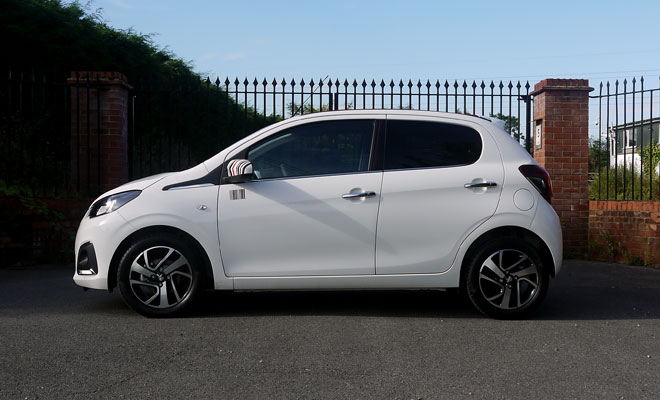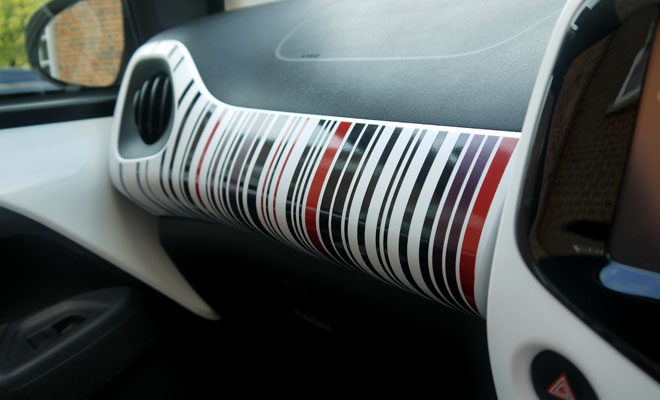by Lem Bingley 
While the Citroen C1 resembles a sort of surprised frog on wheels, and the Toyota Aygo appears to be the severed head of a giant puzzled robot, the 108, by contrast, looks exactly like a small, sensible city car. It is by far the most sober of the three and arguably all the better for that.
Only from the outside, however. Inside, the three cars are pretty much identical bar the badge glued to the steering wheel. All three are obviously budget transport offering tough, cheap-looking plastics enlivened by bright shiny surfaces and (thankfully optional) colourful stickers. Materials and finishes won’t worry the Volkswagen Up, but the seats are firm and comfy, there’s good all-round vision and the cabin provides a reasonable ambience for the cost.

Talking of which, prices are virtually identical for similar levels of kit across both the 108 and C1, while the Aygo commands a substantial premium over the other two, like for like, for reasons that aren’t at all obvious. The 108 starts at £8,345 for the most basic three-door model, rising to £12,495 for the plushest 5-door before options.
Despite its sensible shoes, the 108 can still get up to a bit of fun, particularly if ordered with a folding fabric roof (or “Top!” according to Peugeot’s over-excited brochure). That’s an option that the C1 also provides (where the folding roof is labelled Airscape) but the Aygo can’t match just yet.

The 108’s sliding roof zips back well behind the door pillars, providing a persuasive open-air feel throughout the car. It glides smoothly back or forth even while the car is on the move, right up to motorway speeds. One quick prod of the overhead switch will open it up fully, while on the way back you’ll need a continuous press to seal things up watertight again, although there is always the option to leave the canvas partially open for a bit of breeze.
A stubby deflector pops up at the front of the aperture to keep buffeting at bay, and it’s partially successful at its job. At higher speeds the bubble of air swept along inside the cabin will boom and flutter with turbulence but at a more modest pace things manage to remain surprisingly serene.

Fully closed, the interior feels snug but not exactly restful. There’s no shortage of noise. The throaty bellow of the exhaust overwhelms what is probably a generous dollop of wind roar and tyre racket too. The bouncy ride completes the set, confirming that refinement is not a word in the 108’s dictionary.
The car does feel nicely nimble, with its electric steering guiding a front end that feels eager to change direction, though the wheel’s action is a little lighter than I’d like. The clutch is perfectly matched to the steering, meaning it’s gossamer light and not prone to giving away any secrets, such as where the biting point might be. The 108 would be a nice car to learn to drive in were it not for its toothless clutch – the Hyundai i10, by contrast, has a bite so marked it feels as if it might nip at your toes, making hill starts much less of a trial.
At least the five-speed gearbox does its best to compensate, providing a shift action that feels as neat and precise as two Lego bricks snapping together.

Two petrol engines are offered. Either offers up a frugal three cylinders and power outputs are boosted by turbocharging. The 1.0-litre option provides up to 68bhp and a peak torque supply of 95Nm, while the 1.2-litre option provides up to 80bhp and 116Nm. Both are loud but seldom unpleasantly gruff.
The smaller engine can get the 108 to 62mph in 14.3 seconds, while the extra fifth of a litre cuts the other engine’s time down to just 11 seconds. No doubt the gap in performance will feel a lot wider if the little car is anywhere near fully laden – the smaller engine is not well suited to steep hills, heavy loads or urgent overtaking.
Peugeot’s plusher trim levels are available only with the bigger engine, while the two lower trim options offer no choice but the smaller one. The entry point for the 1.2 engine starts at £11,095.

The 1.0-litre engine is available with or without fuel-saving stop-start technology (which is a standard feature of the 1.2-litre option). Choosing stop-start costs an extra £250 and trims the car’s CO2 rating from 95g/km to 88g/km. In concert, combined-cycle economy improves from 68.9mpg to 74.3mpg.
The 1.2-litre engine is rated at 99g/km and 65.7mpg. Opting for an automated transmission slightly cuts the bigger engine’s CO2 rating to 97g/km, but only by turning the car into a slug. The automatic’s sprint to 62mph takes more than three seconds longer than the manual car’s at 14.3 seconds.
Away from the simulated world of test cycles and rolling roads, both engines will probably deliver similar actual economy, in the 40 to 50mpg ballpark, depending on how briskly you like to drive. If you can stretch to it, the bigger engine is the one to go for.


Peugeot 108
Rating: stars
Good: open roof option, neat styling
Bad: noisy, cramped, numb clutch
Price: from £8,345
Despite the roaring lion on its nose, the 108 is not exactly pure Peugeot. It makes up one third of a trio of small cars built in the Czech Republic, in a joint venture between Toyota, Peugeot and Citroen. Though they are virtually identical under the skin, the three cars all look very different on the outside. Rating: stars
Good: open roof option, neat styling
Bad: noisy, cramped, numb clutch
Price: from £8,345
While the Citroen C1 resembles a sort of surprised frog on wheels, and the Toyota Aygo appears to be the severed head of a giant puzzled robot, the 108, by contrast, looks exactly like a small, sensible city car. It is by far the most sober of the three and arguably all the better for that.
Only from the outside, however. Inside, the three cars are pretty much identical bar the badge glued to the steering wheel. All three are obviously budget transport offering tough, cheap-looking plastics enlivened by bright shiny surfaces and (thankfully optional) colourful stickers. Materials and finishes won’t worry the Volkswagen Up, but the seats are firm and comfy, there’s good all-round vision and the cabin provides a reasonable ambience for the cost.

Talking of which, prices are virtually identical for similar levels of kit across both the 108 and C1, while the Aygo commands a substantial premium over the other two, like for like, for reasons that aren’t at all obvious. The 108 starts at £8,345 for the most basic three-door model, rising to £12,495 for the plushest 5-door before options.
Despite its sensible shoes, the 108 can still get up to a bit of fun, particularly if ordered with a folding fabric roof (or “Top!” according to Peugeot’s over-excited brochure). That’s an option that the C1 also provides (where the folding roof is labelled Airscape) but the Aygo can’t match just yet.

The 108’s sliding roof zips back well behind the door pillars, providing a persuasive open-air feel throughout the car. It glides smoothly back or forth even while the car is on the move, right up to motorway speeds. One quick prod of the overhead switch will open it up fully, while on the way back you’ll need a continuous press to seal things up watertight again, although there is always the option to leave the canvas partially open for a bit of breeze.
A stubby deflector pops up at the front of the aperture to keep buffeting at bay, and it’s partially successful at its job. At higher speeds the bubble of air swept along inside the cabin will boom and flutter with turbulence but at a more modest pace things manage to remain surprisingly serene.

Fully closed, the interior feels snug but not exactly restful. There’s no shortage of noise. The throaty bellow of the exhaust overwhelms what is probably a generous dollop of wind roar and tyre racket too. The bouncy ride completes the set, confirming that refinement is not a word in the 108’s dictionary.
The car does feel nicely nimble, with its electric steering guiding a front end that feels eager to change direction, though the wheel’s action is a little lighter than I’d like. The clutch is perfectly matched to the steering, meaning it’s gossamer light and not prone to giving away any secrets, such as where the biting point might be. The 108 would be a nice car to learn to drive in were it not for its toothless clutch – the Hyundai i10, by contrast, has a bite so marked it feels as if it might nip at your toes, making hill starts much less of a trial.
At least the five-speed gearbox does its best to compensate, providing a shift action that feels as neat and precise as two Lego bricks snapping together.

Two petrol engines are offered. Either offers up a frugal three cylinders and power outputs are boosted by turbocharging. The 1.0-litre option provides up to 68bhp and a peak torque supply of 95Nm, while the 1.2-litre option provides up to 80bhp and 116Nm. Both are loud but seldom unpleasantly gruff.
The smaller engine can get the 108 to 62mph in 14.3 seconds, while the extra fifth of a litre cuts the other engine’s time down to just 11 seconds. No doubt the gap in performance will feel a lot wider if the little car is anywhere near fully laden – the smaller engine is not well suited to steep hills, heavy loads or urgent overtaking.
Peugeot’s plusher trim levels are available only with the bigger engine, while the two lower trim options offer no choice but the smaller one. The entry point for the 1.2 engine starts at £11,095.

The 1.0-litre engine is available with or without fuel-saving stop-start technology (which is a standard feature of the 1.2-litre option). Choosing stop-start costs an extra £250 and trims the car’s CO2 rating from 95g/km to 88g/km. In concert, combined-cycle economy improves from 68.9mpg to 74.3mpg.
The 1.2-litre engine is rated at 99g/km and 65.7mpg. Opting for an automated transmission slightly cuts the bigger engine’s CO2 rating to 97g/km, but only by turning the car into a slug. The automatic’s sprint to 62mph takes more than three seconds longer than the manual car’s at 14.3 seconds.
Away from the simulated world of test cycles and rolling roads, both engines will probably deliver similar actual economy, in the 40 to 50mpg ballpark, depending on how briskly you like to drive. If you can stretch to it, the bigger engine is the one to go for.




